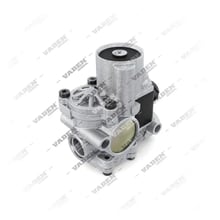ABS Solenoid Modulator Valve: Essential for a Safe and Efficient Braking System
A reliable braking system is crucial for safe driving, and modern vehicles rely on ABS (Anti-lock Braking System) to prevent wheel lockup during sudden braking. One of the most critical components of this system is the ABS Solenoid Modulator Valve, which regulates hydraulic pressure to optimize braking performance.
In this article, we will explore what an ABS Solenoid Modulator Valve is, how it works, why it's important, and common signs of failure.
What is an ABS Solenoid Modulator Valve?
The ABS Solenoid Modulator Valve is an essential component of the ABS system that controls the flow of brake fluid. It adjusts hydraulic pressure based on real-time data from wheel speed sensors, preventing wheels from locking up and ensuring better traction on the road.
This valve plays a key role in increasing, decreasing, or maintaining brake pressure to maximize braking efficiency and vehicle stability.
How Does the ABS Solenoid Modulator Valve Work?
1️⃣ Wheel Speed Sensors Collect Data – The ABS system monitors the speed of each wheel in real-time.
2️⃣ ABS Control Unit Analyzes the Data – If a wheel is about to lock up, the control unit detects the issue.
3️⃣ Solenoid Modulator Valve Adjusts Brake Pressure – It regulates the hydraulic flow to prevent skidding.
4️⃣ Optimal Braking Pressure is Maintained – The system continuously adjusts pressure to ensure safe stopping.
This process happens within milliseconds, allowing the driver to maintain control of the vehicle even under emergency braking conditions.
Why is the ABS Solenoid Modulator Valve Important?
✔ Prevents wheel lockup during braking.
✔ Enhances vehicle stability on slippery roads.
✔ Reduces braking distance, improving safety.
✔ Extends the lifespan of tires and brake components.
Signs of a Failing ABS Solenoid Modulator Valve
If your ABS solenoid modulator valve malfunctions, you may notice the following symptoms:
🔴 ABS Warning Light Turns On – The ABS light on your dashboard may indicate a system failure.
🔴 Wheels Lock Up During Braking – If the ABS system fails, wheels may skid on slippery surfaces.
🔴 Brake Pedal Feels Hard or Spongy – Unusual brake pedal behavior can signal ABS valve issues.
🔴 Delayed Brake Response – If your brakes take longer to respond, the ABS system may not be functioning properly.
How to Fix ABS Solenoid Modulator Valve Issues?
🔧 Run a Diagnostic Test – Connect your vehicle to an OBD scanner to check for ABS error codes.
🔧 Clean the ABS Valve – Contaminated brake fluid can affect valve performance, so regular maintenance is essential.
🔧 Replace the Valve or ABS Unit – If the valve is severely damaged, a replacement may be necessary.
How to Choose the Right ABS Solenoid Modulator Valve?
✅ Ensure Compatibility with Your Vehicle – Different vehicles require different ABS valves.
✅ Choose High-Quality or OEM Parts – Avoid cheap aftermarket parts that may compromise safety.
✅ Have It Installed by a Professional – ABS valve replacement requires expert knowledge and proper tools.
Conclusion: Maintain Your ABS System for Safer Driving!
The ABS Solenoid Modulator Valve is a crucial component that ensures the stability and efficiency of your braking system. Regular maintenance and prompt repairs can help prevent accidents and keep your vehicle in top condition.
🚗 Stay safe on the road by keeping your ABS system in perfect working order!












